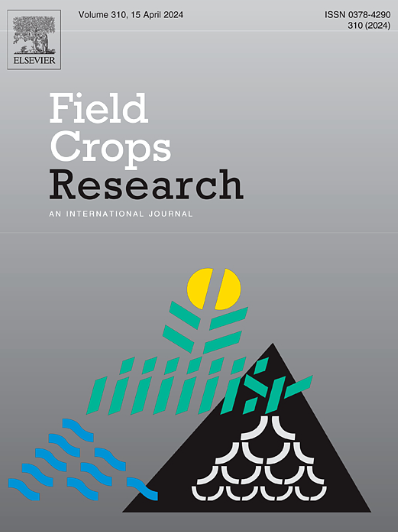Effects of phenological uniformity on prediction accuracy of wheat yield and biomass
IF 5.6
1区 农林科学
Q1 AGRONOMY
引用次数: 0
Abstract
Context
Accurate prediction of wheat yield and biomass is essential for breeding new cultivars and optimizing field management. The accuracy of yield and biomass predictions can be affected by the phenological phase of data collection. However, phenological transitions are gradual, and wheat fields rarely consist of a single phenological stage. The influence of phenological uniformity (PU) on prediction accuracy has been largely overlooked, particularly in multi-cultivar study areas.
Objective
This study aimed to quantitatively evaluate PU, to classify wheat phenological stages using hyperspectral data collected by an unmanned aerial vehicle (UAV), to identify the optimal growth stage for yield and biomass prediction, and to assess the impact of PU on prediction accuracy.
Methods
A two-year field experiment was conducted using 210 wheat cultivars with diverse phenological stages, and time-series hyperspectral images were collected using an UAV. The study first defined and quantitatively evaluated PU. Subsequently, the classification accuracies of five models were compared to identify the most effective approach for phenological stage classification. Hyperspectral data collected at four key growth stages were then used to determine the optimal stage for yield and biomass prediction. Finally, datasets with varying PU were constructed to predict yield and biomass, and the influence of PU on prediction accuracy was assessed.
Results
PU of wheat exhibited a fluctuating trend throughout the growth stages, with most values ranging between 0.5 and 0.8. Hyperspectral data enabled effective discrimination of key phenological stages, among which the end-to-end mixhop superpixel-based graph convolutional networks (EMS-GCN) model achieved the highest classification accuracy, with an overall accuracy of 86.2 %. The PLSR model achieved the most accurate predictions of both yield (R² = 0.692, RMSE = 1.091 t/ha, CV = 0.152) and biomass (R² = 0.827, RMSE = 1.873 t/ha, CV = 0.113) at the flowering stage. The results of yield and biomass prediction based on datasets with varying PU values indicated a positive correlation between PU and prediction accuracy.
Conclusions
Accurate classification of key wheat phenological stages can be achieved by combining deep learning with hyperspectral data. The flowering stage is the optimal period for yield and biomass prediction. PU positively correlates with the prediction accuracy of yield and biomass.
Implications
This study emphasizes the important role of PU in wheat yield and biomass prediction, and accurate monitoring of PU can provide theoretical guidance for data collection. This is of great significance to the development of precision agriculture and guiding field management.
物候均匀性对小麦产量和生物量预测精度的影响
小麦产量和生物量的准确预测是小麦新品种选育和田间管理优化的基础。产量和生物量预测的准确性可能受到数据收集的物候阶段的影响。然而,物候转变是渐进的,麦田很少由单一的物候阶段组成。物候均匀性(PU)对预测精度的影响在很大程度上被忽视,特别是在多品种研究区。目的对小麦物候期进行定量评价,利用无人机(UAV)采集的高光谱数据对小麦物候期进行分类,确定产量和生物量预测的最佳生长期,并评估其对预测精度的影响。方法对210个不同物候期小麦品种进行为期2年的田间试验,利用无人机采集时间序列高光谱图像。本研究首次对PU进行了定义和定量评价。随后,比较了5种模型的分类精度,以确定最有效的物候阶段分类方法。然后利用在四个关键生长阶段收集的高光谱数据来确定产量和生物量预测的最佳阶段。最后,构建不同PU值的数据集对产量和生物量进行预测,并评估PU值对预测精度的影响。结果小麦spu在整个生育期呈波动趋势,大部分在0.5 ~ 0.8之间。高光谱数据能够有效识别关键物候阶段,其中端到端mixhop超像素图卷积网络(EMS-GCN)模型的分类准确率最高,总体准确率为86.2 %。PLSR模型对花期产量(R²= 0.692,RMSE = 1.091 t/ha, CV = 0.152)和生物量(R²= 0.827,RMSE = 1.873 t/ha, CV = 0.113)的预测最为准确。基于不同PU值数据集的产量和生物量预测结果表明,PU与预测精度呈正相关。结论将深度学习与高光谱数据相结合,可以实现小麦物候关键阶段的准确分类。开花期是预测产量和生物量的最佳时期。PU与产量和生物量的预测精度呈正相关。本研究强调了PU在小麦产量和生物量预测中的重要作用,准确监测PU可以为数据收集提供理论指导。这对发展精准农业,指导田间管理具有重要意义。
本文章由计算机程序翻译,如有差异,请以英文原文为准。
求助全文
约1分钟内获得全文
求助全文
来源期刊

Field Crops Research
农林科学-农艺学
CiteScore
9.60
自引率
12.10%
发文量
307
审稿时长
46 days
期刊介绍:
Field Crops Research is an international journal publishing scientific articles on:
√ experimental and modelling research at field, farm and landscape levels
on temperate and tropical crops and cropping systems,
with a focus on crop ecology and physiology, agronomy, and plant genetics and breeding.
 求助内容:
求助内容: 应助结果提醒方式:
应助结果提醒方式:


